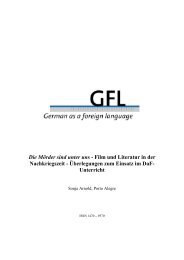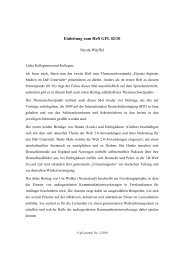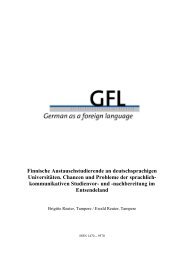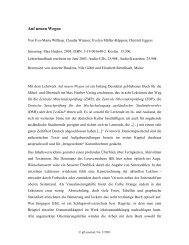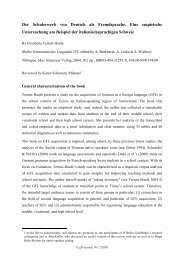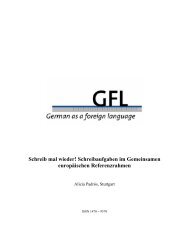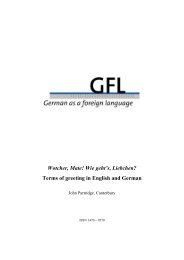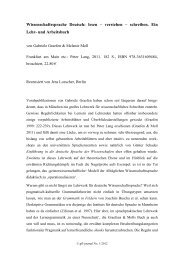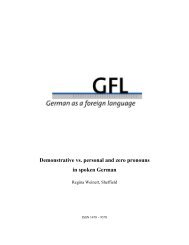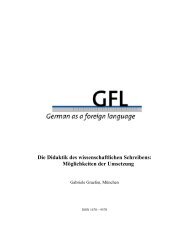Drama and Authentic Movement as Intercultural ... - GFL
Drama and Authentic Movement as Intercultural ... - GFL
Drama and Authentic Movement as Intercultural ... - GFL
You also want an ePaper? Increase the reach of your titles
YUMPU automatically turns print PDFs into web optimized ePapers that Google loves.
<strong>Drama</strong> <strong>and</strong> <strong>Authentic</strong> <strong>Movement</strong> <strong>as</strong> <strong>Intercultural</strong> Communication Skill<br />
129<br />
4) The witness may or may not share a particular perception of the mover’s movement, e. g.<br />
“I imagine a wounded animal lying on the ground lifting his foreleg”.<br />
These four principles are not always present in a feedback round. The most important part<br />
is to start off with the description of the movement <strong>and</strong> then follow it up with the other<br />
<strong>as</strong>pects of the witness’s experience. The witness speaks in the first person singular to make<br />
sure that the feedback stays with him/her <strong>and</strong> to allow the mover the opportunity of<br />
agreeing or disagreeing with his/her response. The witness always speaks in the present<br />
tense <strong>and</strong> <strong>as</strong>ks the mover whether he/she wants to hear any feedback. If the witness is not<br />
sure about what he/she h<strong>as</strong> seen or h<strong>as</strong> forgotten parts of the sequence, it may be enough to<br />
say: “I see you” or “I hear you”.<br />
<strong>Authentic</strong> <strong>Movement</strong> is practised in many varied contexts such <strong>as</strong> psychotherapy,<br />
personal/creative investigation <strong>and</strong> <strong>as</strong> a source of original artistic creation in dance, theatre,<br />
writing <strong>and</strong> the visual arts.<br />
3. <strong>Authentic</strong> <strong>Movement</strong> <strong>as</strong> an intercultural communication skill – an approach<br />
The principles of <strong>Authentic</strong> <strong>Movement</strong> <strong>and</strong>, above all, the witnessing <strong>as</strong>pect appear to be<br />
particularly helpful in an intercultural context. In combination with exercises drawn from<br />
drama-in-education, a foundation may be laid for initiating non-verbal contact, which may<br />
then be exp<strong>and</strong>ed to include some form of verbal exchange. The emph<strong>as</strong>is here is precisely<br />
on the initial non-verbal impressions, the messages of body language that may prove<br />
decisive in opening channels of communication. Embedding <strong>Authentic</strong> <strong>Movement</strong> in an<br />
intercultural context is a new approach to intercultural encounters which h<strong>as</strong> yet to be<br />
explored on a more theoretical b<strong>as</strong>is.<br />
To begin with, it seems essential to offer simple exercises in order to enable all participants<br />
to make contact with one another. During our workshop in Irel<strong>and</strong>, the participants were<br />
encouraged to do simple walking exercises with their eyes open or closed, with or without a<br />
partner. They began their search for a partner with their eyes open, i.e. quite consciously.<br />
One of the exercises encouraged the participants to meet <strong>and</strong> greet each other. Here they<br />
had to focus on how they wanted to greet the other person: did they want to shake h<strong>and</strong>s,<br />
© gfl-journal, No. 1/2004



